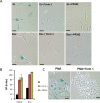Dual mTORC1/C2 inhibitors suppress cellular geroconversion (a senescence program)
- PMID: 26177051
- PMCID: PMC4695114
- DOI: 10.18632/oncotarget.4836
Dual mTORC1/C2 inhibitors suppress cellular geroconversion (a senescence program)
Abstract
In proliferating cells, mTOR is active and promotes cell growth. When the cell cycle is arrested, then mTOR converts reversible arrest to senescence (geroconversion). Rapamycin and other rapalogs suppress geroconversion, maintaining quiescence instead. Here we showed that ATP-competitive kinase inhibitors (Torin1 and PP242), which inhibit both mTORC1 and TORC2, also suppressed geroconversion. Despite inhibition of proliferation (in proliferating cells), mTOR inhibitors preserved re-proliferative potential (RP) in arrested cells. In p21-arrested cells, Torin 1 and PP242 detectably suppressed geroconversion at concentrations as low as 1-3 nM and 10-30 nM, reaching maximal gerosuppression at 30 nM and 300 nM, respectively. Near-maximal gerosuppression coincided with inhibition of p-S6K(T389) and p-S6(S235/236). Dual mTOR inhibitors prevented senescent morphology and hypertrophy. Our study warrants investigation into whether low doses of dual mTOR inhibitors will prolong animal life span and delay age-related diseases. A new class of potential anti-aging drugs can be envisioned.
Keywords: Gerotarget; Pathology Section; aging; pan-mTOR inhibitors; rapalogs; rapamycin; senescence.
Conflict of interest statement
MVB is a consultant at Everon Biosciences, Inc.
Figures




Comment in
-
Dual mTORC1/C2 inhibitors: gerosuppressors with potential anti-aging effect.Oncotarget. 2015 Sep 15;6(27):23052-4. doi: 10.18632/oncotarget.5563. Oncotarget. 2015. PMID: 26375366 Free PMC article.
Similar articles
-
From rapalogs to anti-aging formula.Oncotarget. 2017 May 30;8(22):35492-35507. doi: 10.18632/oncotarget.18033. Oncotarget. 2017. PMID: 28548953 Free PMC article. Review.
-
Dual mTORC1/C2 inhibitors: gerosuppressors with potential anti-aging effect.Oncotarget. 2015 Sep 15;6(27):23052-4. doi: 10.18632/oncotarget.5563. Oncotarget. 2015. PMID: 26375366 Free PMC article.
-
Gerosuppression by pan-mTOR inhibitors.Aging (Albany NY). 2016 Dec 30;8(12):3535-3551. doi: 10.18632/aging.101155. Aging (Albany NY). 2016. PMID: 28077803 Free PMC article.
-
Rapamycin, proliferation and geroconversion to senescence.Cell Cycle. 2018;17(24):2655-2665. doi: 10.1080/15384101.2018.1554781. Epub 2018 Dec 12. Cell Cycle. 2018. PMID: 30541374 Free PMC article.
-
Cell senescence, rapamycin and hyperfunction theory of aging.Cell Cycle. 2022 Jul;21(14):1456-1467. doi: 10.1080/15384101.2022.2054636. Epub 2022 Mar 31. Cell Cycle. 2022. PMID: 35358003 Free PMC article. Review.
Cited by
-
From rapalogs to anti-aging formula.Oncotarget. 2017 May 30;8(22):35492-35507. doi: 10.18632/oncotarget.18033. Oncotarget. 2017. PMID: 28548953 Free PMC article. Review.
-
Altered modulation of lamin A/C-HDAC2 interaction and p21 expression during oxidative stress response in HGPS.Aging Cell. 2018 Oct;17(5):e12824. doi: 10.1111/acel.12824. Epub 2018 Aug 15. Aging Cell. 2018. PMID: 30109767 Free PMC article.
-
Lysosomal trapping of palbociclib and its functional implications.Oncogene. 2019 May;38(20):3886-3902. doi: 10.1038/s41388-019-0695-8. Epub 2019 Jan 28. Oncogene. 2019. PMID: 30692638 Free PMC article.
-
Inverse correlation between longevity and developmental rate among wild C. elegans strains.Aging (Albany NY). 2016 May;8(5):986-99. doi: 10.18632/aging.100960. Aging (Albany NY). 2016. PMID: 27193830 Free PMC article.
-
Accelerated geroncogenesis in hereditary breast-ovarian cancer syndrome.Oncotarget. 2016 Mar 15;7(11):11959-71. doi: 10.18632/oncotarget.7867. Oncotarget. 2016. PMID: 26943589 Free PMC article.
References
-
- Kenyon C, Chang J, Gensch E, Rudner A, Tabtiang R. A C. elegans mutant that lives twice as long as wild type. Nature. 1993:461–464. - PubMed
-
- Kenyon C. The plasticity of aging: insights from long-lived mutants. Cell. 2005;120:449–460. - PubMed
-
- Vellai T, Takacs-Vellai K, Zhang Y, Kovacs AL, Orosz L, Muller F. Genetics: influence of TOR kinase on lifespan in C. elegans. Nature. 2003;426:620. - PubMed
-
- Kaeberlein M, Powers RWr K.K. S, Westman EA, Hu D, Dang N, Kerr EO, Kirkland KT, Fields S, Kennedy BK. Regulation of yeast replicative life span by TOR and Sch9 in response to nutrients. Science. 2005;310:1193–1196. - PubMed
MeSH terms
Substances
LinkOut - more resources
Full Text Sources
Other Literature Sources
Medical
Research Materials
Miscellaneous

